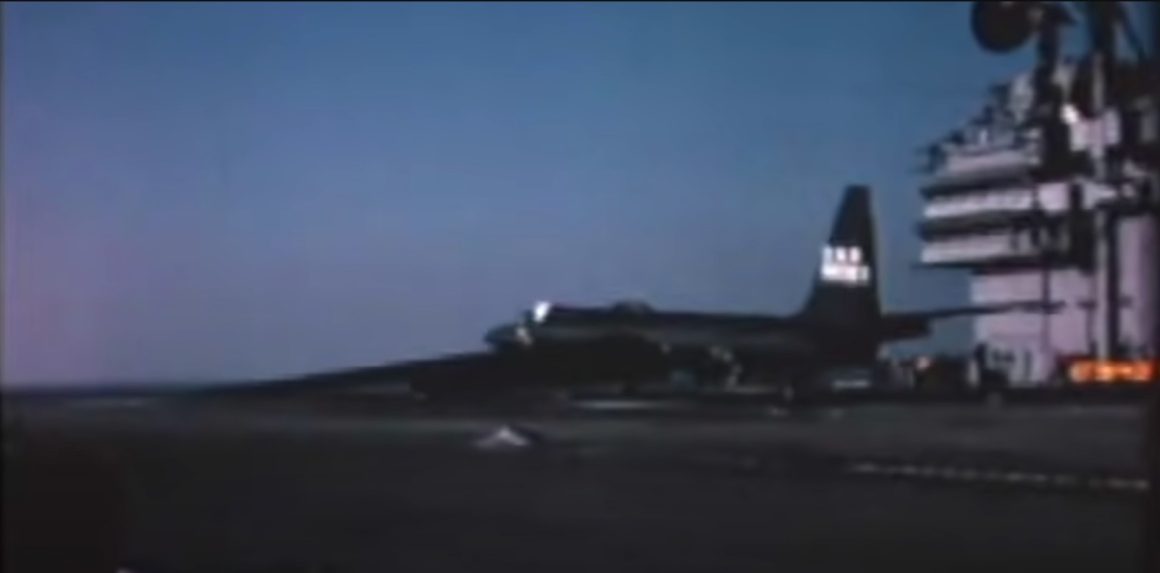The U-2 Dragonfly was not only tested on a carrier; the jet also successfully carried out a CIA spy mission.
A while ago, we wrote an article about a C-130 that did carrier trials. As hard as it is to believe, a Lockheed KC-130F Hercules tanker conducted a series of test landings and takeoffs from the deck of the USS Forrestal (CVA-59). The crew made 29 touch-and-go landings, 21 full-stop landings, and 21 unassisted takeoffs. They were deck-run takeoffs (without catapult assist) while weighing from 85,000 pounds all the way up to 121,000 pounds.
The KC-130 wasn’t the only unique aircraft trialed by the Navy. Did you know that a U-2 was actually tested on an aircraft carrier as well?
Less than a year after the KC-130 conducted tests, the U-2 attempted to land on the deck of the USS Ranger (CVA-61). The U-2, specially modified and known as a U-2G, had additional equipment added to it in order to support carrier ops. The plane had strengthened gear and a tail hook to enable carrier operations.
Why did they need a U-2 on an aircraft carrier?
At the time, the CIA saw the U-2 as the ideal observation and spy platform. Unfortunately, the U-2 was also a very sensitive platform–both militarily and politically. Just a few years earlier, Francis Gary Powers’ U-2 was shot down over the Soviet Union. Many of the United States’ most trusted allies worried that hosting the spy aircraft could lead to riling up the then very powerful and influential Soviet Union.
Thus, Operation Project Whale Tale was launched. It was conceived as a way to launch necessary spy activities in both areas that were previously difficult to access. A side effect was to avoid any political entanglements from launching from allied territories.

Was it a standard U-2?
The U-2 that they used for the test was an off-the-shelf U-2 with some important modifications. The modified spy jet, then renamed the U-2G, required strengthened landing gear and internal structures to handle the loads of a carrier landing. It also needed an arrestor hook.
The pilots selected for this program trained on the modified aircraft. Learning to operate the aircraft in such tight spaces was no small feat. Remember that landing a U-2 is no easy feat, even under normal conditions. Visibility in the aircraft is poor. This is due to the aircraft’s design and the pilots wearing a visibility-limiting spacesuit in a tight, fighter-like cockpit. On short final, the spy plane pilot is talked down by a guide vehicle (usually a sports car) that rendezvous with the aircraft on the runway.
Below is a video of a typical U-2 approach, highlighting the challenge of landing a U-2 on an 8,000+ foot runway, courtesy of our friends at AirshowStuff.
It wasn’t perfect but, landing a U-2 on a carrier was possible!
According to an excellent synopsis in Air and Space Forces Magazine, testing began in 1963 when a standard U-2 with the aforementioned modifications was hoisted onto the deck of the Kitty Hawk. Lockheed test pilot Bob Schumacher took off with a full fuel load and a deck run of 321 feet. A CIA report on subsequent landing tests stated that “the aircraft bounced, hit hard on one wingtip, and then barely managed to become airborne again before reaching the end of the deck.”
After reviewing the test data, the U-2 was further modified with flight control modifications, like spoilers, to increase control and decrease lift for the more precise carrier landings. The upgraded model became known as the U-2G. The first successful (and uneventful) landing occurred on 2 March 1964.

Just two months later, the CIA selected the U-2G for assignment in an operation known as Operation Fish Hawk. The mission was to observe French nuclear activity in the South Pacific. The U-2 was the perfect aircraft for such a feat.
According to the CIA website, “The U-2G took off successfully on 19 May 1964, but cloud cover obscured a number of the targets, so a second mission was authorized for 23 May. This sortie succeeded brilliantly, capturing high-quality photographs of all targets. The after-action report read, “From an operational and security standpoint, this was one of the most successful operations of this nature ever conducted by the United States.” Detailed analysis of the photography resulted in an in-depth report in August 1964 that fully answered questions concerning the major aspects of the French nuclear program.”
Why Did the U-2 carrier program end?
While the mission was successful, the U-2 carrier program did not last. The reasons for its demise were twofold. By the mid-1960s, the U-2 was no longer the only choice for observation and high-quality imagery missions. Other platforms were emerging that offered better and safer ways to spy. High-resolution spy space satellites, as well as the much faster SR-71, were becoming a reality.
The other catalyst behind the demise of the sea-based U-2G was the fact that the aircraft was never ideal for an aircraft carrier. After all, the U-2 had a large footprint on a relatively small deck of carriers from that day. Besides its relatively large size, operating a giant glider-winged jet that is notoriously squirrely from such a small flight deck was always risky.
With better options, it became almost a no-brainer to back away from such a difficult program.
